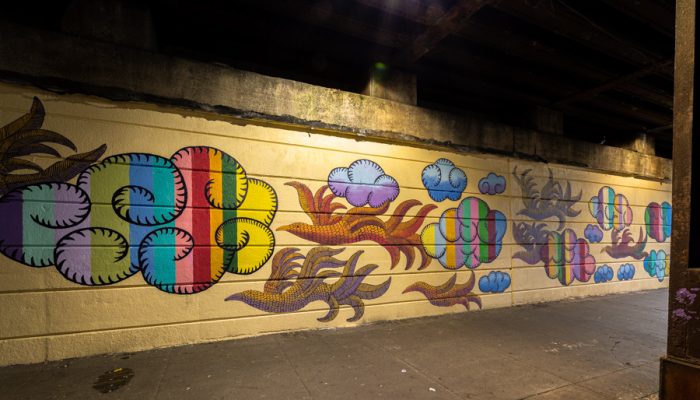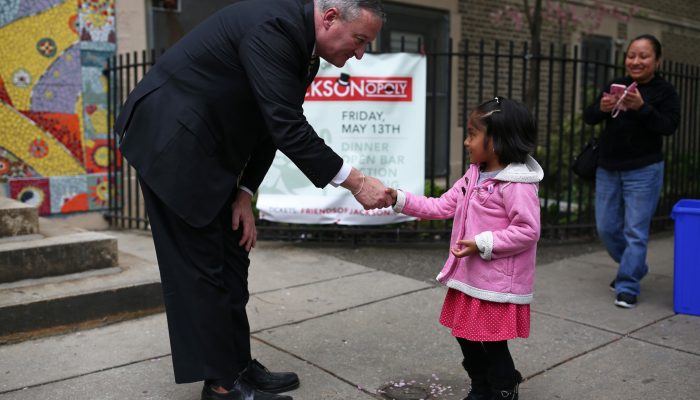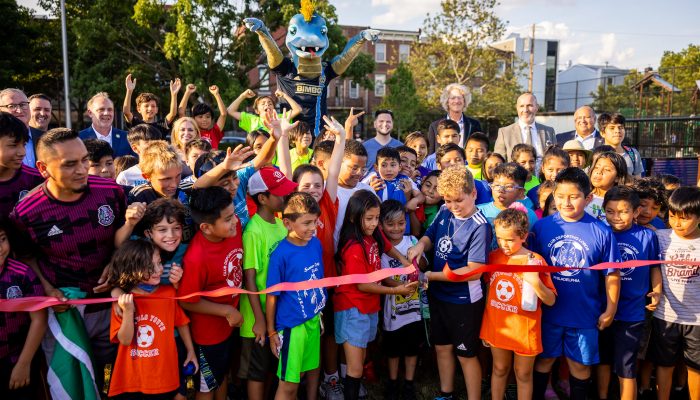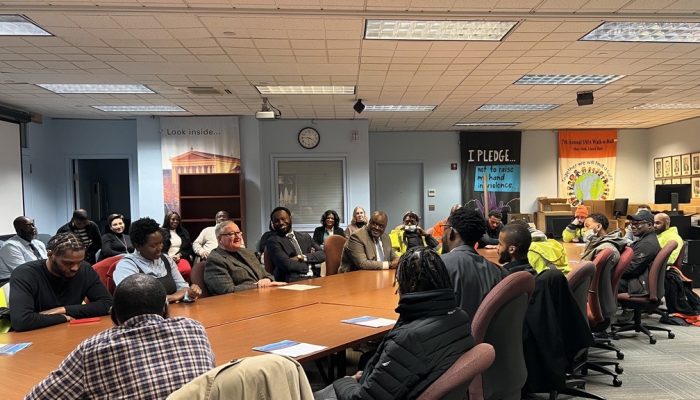October 16 marked the one-year anniversary of the Philadelphia Resilience Project.
In recognition of the milestone, Mayor Kenney, City Councilmembers, and community members celebrated a new neighborhood mural created by Mural Arts Philadelphia called Free and Clean.
This bright and vibrant piece of public art spans the Kensington and Lehigh avenues underpass, which was the location of an encampment site one year ago. The mural highlights the strength and determination of the Kensington and Fairhill communities and serves as a reminder of all that has been accomplished.
Resilience Project background and mission
When Mayor Jim Kenney signed an executive order declaring an emergency response to the opioid crisis in 2018, 35 City offices and agencies mobilized. Their goals: Help people suffering from substance use disorder, and support residents living in the Kensington and Fairhill neighborhoods, the areas most affected by the epidemic.
The comprehensive approach addressed the epidemic from multiple angles—from providing low-barrier access to treatment and housing to beautification efforts throughout the community.
One-year accomplishments
Here’s an overview of the progress we’ve made over the past year. Full details of our team’s efforts can be found in the Philadelphia Resilience Project Report, released in June 2019.
Clear encampments
By the time the Resilience Project began in November, our team had already successfully and humanely closed two of the four large encampments in Kensington. We used that experience to address the remaining locations, which were hubs for drug use, criminal activity, and dangerous conditions.
Highlights of our work:
- Cleared all major encampments, which have not been re-encamped.
- Connected people to services, with more than half housed or in treatment.
- Created a plan on how to address future encampments.
- Shared our encampment plan to be used both locally and across the nation.
Reduce criminal activity
We’ve worked to reduce drug-related crime in this community which has been hit the hardest for decades. With the help of City offices, including the Philadelphia Police Department, partner organizations, and residents, we’ve established a data-informed strategy to crime reduction.
Highlights of our work:
- Increased safety measures for children by employing foot and bike patrols and creating Safe Corridor routes for travel to and from schools.
- Installed 1,000 LED street lights and additional cameras in Kensington.
- Worked more closely with federal and state partners to address narcotic supply and distribution.
- Created a new protocol for police officers to disrupt nuisance behaviors that negatively impact quality-of-life for local residents.
Reduce the number of unsheltered individuals
Since the start of the Philadelphia Resilience Project, we’ve been able to reduce our homeless population. We’ve seen significant progress, but we are working to help the hundreds of people who are still on the street and to expand housing options and services.
Highlights of our work:
- Reduced the number of unsheltered residents.
- Established another 24-hour Navigation Center for wrap-around services.
- Expanded emergency and temporary housing to 220 beds in the target area.
- Added 210 long-term housing opportunities for those most in need.
Reduce trash and litter
We’ve seen much success in our work to revitalize Kensington and improve the quality of life for all residents. Through major cleanups, mural projects, needle disposal, and other programs, we’re continuing to beautify the neighborhood and build a sense of pride in the community.
Highlights of our work:
- Conducted eight large cleanups and three small cleanups with 935 volunteers.
- Removed more than 375 tons of trash and over 600 abandoned vehicles.
- Launched a weekly street sweeping program.
- Initiated a new needle collection program and installed ten needle disposal containers.
Reduce overdoses and the spread of infectious disease
Our goal since the start of the Philadelphia Resilience Project has been to save lives. That’s why we’ve focused on helping people with opioid use disorder access treatment and medical care services to keep affected communities healthy and safe.
Highlights of our work:
- Increased distribution of naloxone (Narcan) and related training.
- Installed handwashing stations and provided more than 3,500 vaccines to address the spread of Hepatitis A.
- Conducted nearly 2,500 HIV tests in Kensington.
- Distributed opioid prescribing guidelines to 16,000 healthcare providers by mail and another 1,300 by direct, in-person outreach.
Increase Medication Assisted Treatment
Medication-assisted treatment (MAT) has been found to be the most effective form of treatment for opioid use disorder. We focused our efforts on ensuring access to this service for those who need it.
Highlights of our work:
- Deployed mobile outreach teams including medical professionals to provide Medication-assisted treatment (MAT).
- Launched a Treatment Availability Database (TAD), which provides real-time information about bed availability.
- Continued working with First Step Staffing to connect individuals in recovery to employment.
- Created an EMS response unit staffed by a paramedic, case manager, and social worker to connect individuals with services after responding to an opioid overdose.
Mobilize community response
We knew that in order for this long-term project to be successful, we needed to engage community members and learn from their first-hand experiences. That’s why we’ve organized monthly volunteer cleanups and community meetings to empower residents to become leaders who can carry out the work long after the Resilience Project has ended.
Highlights of our work:
- Created a dedicated Philly311 unit to receive direct reports on Kensington/Fairhill and address complaints faster.
- Hosted 31 community and civic meetings.
- Recruited nearly 1,000 volunteers.
- Expanded our bilingual e-newsletter to encourage neighborhood engagement by highlighting Resilience-related work and programs.
Next steps
The Resilience Project will continue its emergency response through December 2019. While the emergency response will formally end on December 31, the work will continue over the next several years.
The next steps will include:
- Working with the community to continue the work of the Resilience Project.
- Raising public and private funding to support the work of community partners.
- Developing and implementing a three-year community and economic development plan for the Kensington/Fairhill area.
- Coordinating with the implementation of the Philadelphia Roadmap for Safer Communities, our citywide violence prevention strategy.
- Developing new strategies to disrupt the public sale and use of narcotics.
- Supporting the establishment of overdose prevention sites.
- Reducing barriers to treatment.




